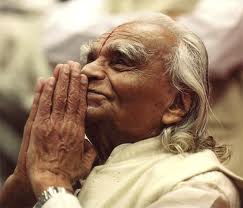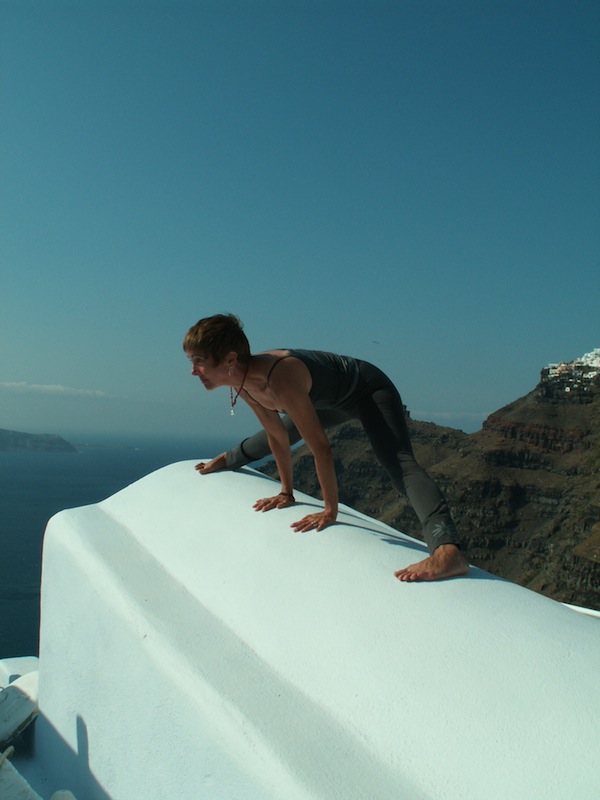I Love Her; She Hates Me (My New Iyengar Yoga Teacher)
Ruminant With A View
by Elizabeth Boleman-Herring
“If you tell a Zen master everything is a dream, she will take her stick and whack you over the head. Then she will ask, ‘Is that a dream?’ Focusing on the big picture is not enough. Form must be honored.”—Jack Kornfield
“Your happiness and suffering depend on your actions and not on my wishes for you.”—Jack Kornfield
TEANECK New Jersey—(Weekly Hubris)—8/22/11—Willy-nilly, over the past six years, I have gone through Iyengar Yoga teachers like pyracantha berries through a famished cedar waxwing.

First, having studied Hatha Yoga on and off since my 30s, I “discovered” Iyengar Yoga at a humble gym in Teaneck, New Jersey, where Instructor Jay Bolsom quickly became my “Gurujay,” and initiated me into the severe discipline of this particular “genre” of Yoga.
If you want to read more—the whole enchilada, in fact—about Mr. B.K.S. Iyengar, the absolute leading light of this demanding discipline, pick up a copy of the master’s Light on Yoga, the first of his great treatises on Yoga, which Mr. Iyengar defines as “the union of our will to the will of God, a poise of the soul which enables one to look evenly at life in all its aspects.” He concludes, “The chief aim of yoga is to teach the means by which the human soul may be completely united with the Supreme Spirit pervading the universe and thus secure absolution.”
A tall order for 21st-century Westerners, indeed.
But that is just what Jay Bolsom was, himself, dedicated to teaching, practicing and attaining, for himself and for those few students who came, through him, to devote themselves as well to Iyengar Yoga. The fact that our practice was held at a noisy, noisome, vermin-infested and mold-pervaded gym in a little New Jersey town not particularly noted for any visible evidence of enlightenment, mattered not a whit to me, or to Jay’s rare other Iyengar-devotees. When I began my studies with him, he had not yet begun his formal Iyengar Teacher Training, nor passed his first assessment . . . but he knew a world more than I about Yoga, about Iyengar’s methodology in particular, and about the human body.
I got injured on his watch—a reversed curve of my cervical spine due to attempting a handless headstand, and a ganglion cyst on my left wrist, the result of my too vigorous attempts to master handstands, too quickly and too early for my fragile tendons. Not Jay’s fault: no one, really, could stop me once I discovered Iyengar. Like the thoroughbred entered too soon (or too late) in the race, who breaks a leg in the first turn, I just got the bit between my teeth and took every class Jay taught.
I lived, breathed, ate, slept and merged-with Yoga.
I also took seminars and master classes at Kim Peralta’s now defunct Iyengar Yoga Studio in Waldwick, where I had the honor of taking a master class from Manouso Manos, one of the most qualified and respected of Iyengar’s hand-picked, hand-trained lineage of master teachers.
Then, seeking Iyengar Teacher Training, myself, I began teaching, alongside Jay, at our rough little Teaneck gym and, over the course of three years, 200 students passed through my very humble classroom. At Teaneck’s Aikido Dojo, my dearest friend here, Sensei Jerry Zimmerman, gave me a beautifully appointed, shrine-like Yoga room in which to teach, but we found we could not compete with the local gym’s prices, and my students there reluctantly followed me back to Club Fit.

Simultaneously, I entered Theresa Rowland’s Iyengar Teacher Training Course in Madison, New Jersey, at Studio Yoga, and embarked upon a year of three-to-six-hour-long seminars, Level IV classes, intense study of the texts and DVDs that document, preserve and convey Mr. Iyengar’s knowledge, and retreats. It was here that I met and studied under Kofi Busia, John Welshon and Genny Kapular: Busia, a giant in international Iyengar circles; Welshon, a guru (“light-bringer”) of meditation; and Genny, an expert in human anatomy as it relates to Iyengar Yoga.
However, all this sturm und drang, this “storm and yearning,” that had possessed my spirit came to a crashing halt on 20 May 2010, when my lumbar spine broke neatly in two at the L4, L5 vertebrae, and neurosurgeon Alfred T. Ogden, bless his soul, put me back together again, unlike Humpty Dumpty, in a beautiful surgical suite at Valley Hospital.
However, while Dr. Ogden had imagined his “elite athlete” would be back on her mat, back in the studio teaching, within two months’ time, it has taken a full calendar year for my insulted spine to consider further discourse with me . . . or the assumption, once more, of asana on a sticky mat. From one day to the next, I lost my life’s greatest (sorry, Dean) passion—and only Iyengar devotees and Balanchine’s former ballerinas will understand this—and my ability to earn a living sharing my (incomplete) knowledge of Iyengar Yoga with my beloved students.
For that is how I taught: I loved both the discipline, the art form, the spiritual exercise that is Mr. Iyengar’s co-creation (his, shared with the long lineage of masters who produced him); and I loved the students in my care. Had I been able to open my very own studio, complete with rope wall, bricks, blankets, belts, and all the other “props” Mr. Iyengar has developed to make asana more accessible to all students, of all abilities, and facing all challenges, I would have named it “The Laughing Yogini.”
This was my dream: to complete Theresa’s Teacher Training Class; to pass at least the first assessment through the Iyengar Yoga Association of Greater New York; and to continue advancing in my own knowledge and skills, while passing on what I was learning, new, each and every day, to my students. After each of Theresa’s seminars and Level III or IV classes, for example, I would return to Teaneck like a parent-bird, some new goody, some new bit of knowledge, in my beak for all those in my nest.
For a month or two, after my surgery, I had every hope that Dr. Ogden’s prognosis would hold . . . but the pain and inflexibility settled in and, though I went religiously to rehab, and practiced and swam as much as I could, in Greece, that autumn of 2010, my body was no longer my own. It had become, perhaps permanently, I accepted, “other.” It would not, it could not, obey the commands of my will, the desires of my heart, as far as asana were concerned.
At some point, in the winter of 2010/11, I stopped struggling entirely. I did not “give up.” I simply listened to what my spine was saying, quite, quite clearly, and the message was this: “You must ask almost nothing of me for the time being. You must be grateful—exceptionally grateful—to be able to walk, even to run. But you must let me rest as long as I need to rest, and not return to your mat a moment before I tell you I am ready.”
So . . . I trained my focus on my life’s other passions: my beloved husband, my writing and publishing, my treasured friends—especially Susan Aguado and Marian Loizides, my two finest former Yoga students, who, to this day, have let not a single day pass without calling, writing or seeing me.
And, in exactly a year from the date of my surgery, something shifted in my spine, and my mobility returned, almost overnight. Still, I find flipping up and over into Halasana, or Plough Pose, is something I must now do in stages, rather than in a single, graceful arc. But my body has rejoined me. Separate, like a dancer and her shadow, for a year, we are now moving again, almost in tandem.
But driving to Madison, for Theresa’s classes, or into New York City, for Genny’s, proved still too much of a strain for me. My muscular strength was two-thirds gone; my former balance was gone; my core was as wobbly as a noodle.
So, around the corner in Teaneck I went, to a studio owned by the Iyengar teacher closest to me geographically, a woman I’ll call Durvāsā, whom Mr. Iyengar describes as “a very irascible sage.”
I don’t know precisely why Durvāsā so dislikes me, but she does. I knew this almost from the first day we met but, most distinctly, after my first practice session with her.
In Durvāsā’s eyes, I’d been taught everything—really, everything—all wrong. “I don’t believe you studied with Theresa!” she said. And then, “How did you ever manage to teach?!”
The very first time all this negativity came barreling towards me from Durvāsā—a first for me, as my Iyengar teachers, one and all (including the late, venerable, Iyengar sage, Mary Dunn, who watched me on an hour-long demo DVD and praised my form)—had been supportive, complimentary; indeed, full of praise. True, Kim Peralta once un-gently thumped me on the back in Adhomukha Virasana, but that thump told me precisely where and how I was in error in the pose, and I never made that particular mistake again.
Still, all in all, I’d been a “good student,” and, I knew in my heart, a “good teacher.” Not, perhaps, a perfect Iyengar-style teacher, but a good-enough, a better-than-good-enough Yoga teacher. Enough observant masters had watched me at work, and acknowledged my skills (and limitations).
Before my back broke. Before my strength evaporated. What Durvāsā has seen before her, these past five weeks, is a still-recovering, seriously injured former athlete. I don’t think she fully grasps this fact, however.
So, when faced with Durvāsā, whom I consider an able Iyengar instructor, truly, I have had consciously, thoughtfully, to decide how to respond to her repeated verbal jabs and slurs. Not given much of an opportunity to speak up for myself—Durvāsā isn’t a chatty, warm, fuzzy teacher—I have chosen to remain as silent as possible in her presence. When confronted with a statement—just for example—like this morning’s, “How did you ever manage to teach?!” I responded, “I taught very well, Durvāsā. I was a fabulous teacher. But, oh, that was before my back broke in two and I lost all my muscle tone. Don’t fret, though,” I added, smiling all the while, “it’s all coming back, thanks to you.”
I went on, “. . . because you are precisely the sort of difficult, diligent, irascible teacher I need just now.” (And, I thought, silently to myself, “Thank God for placing you in my path. I will attend every class with levity and determination, ignore any negativity emanating from your so-alien-from-my-own spirit . . . and I will incorporate all you have learned from the masters of Pune, India, recover my skills and equilibrium, and thrive. Pehaps not by next week, though.”)
So, though she “hates” me, I am determined to love her. And, for the nonce, she’s stuck with me.
She’s a diminutive, muscular powerhouse of an athlete, and can’t, for the life of her, discern the difference between the verbs “to lay” and “to lie”; she’s demanding, but charming to everyone else in the class (all two or three of them, most days); but, last week, she forgot my name entirely, in my eighth class with her.
But . . . she is the teacher who arrived for me. Just now. Just here. And I will struggle and strive to play the part of Astavākra to her Durvāsā.

Astavakra was one “whose body was crooked in eight places,” states Mr. Iyengar, but “who, though born physically deformed, became the spiritual preceptor of King Janaka of Mithilā.”
I only ask, Durvāsā, Respected Teacher, that you, upon occasion, consider my terrible injury, and the fact that, on 13 September of this year, I will turn 60.
Meanwhile, thump, thump away at your imperfect acolyte. I’ve survived fiercer thumpings than anything you can dole out, believe me, and with a big grin on my face.
The Laughing Yogini has indeed returned to her mat.
One Comment
Scott Whitfield
XOXOXOXO!!!! :>)
With love and eternal respect from Ginger, Scott, and Gracie!